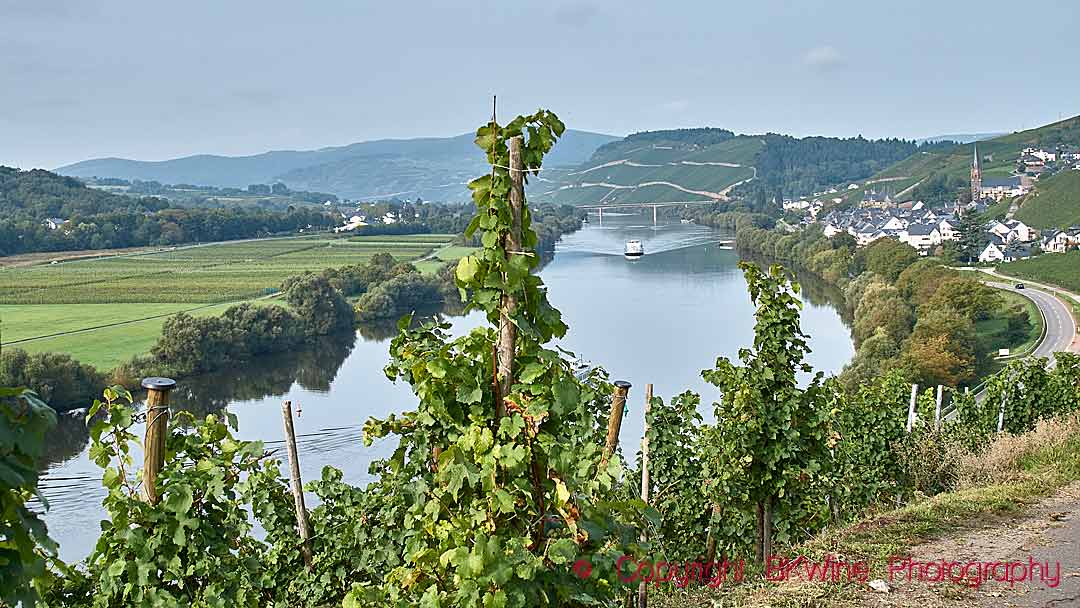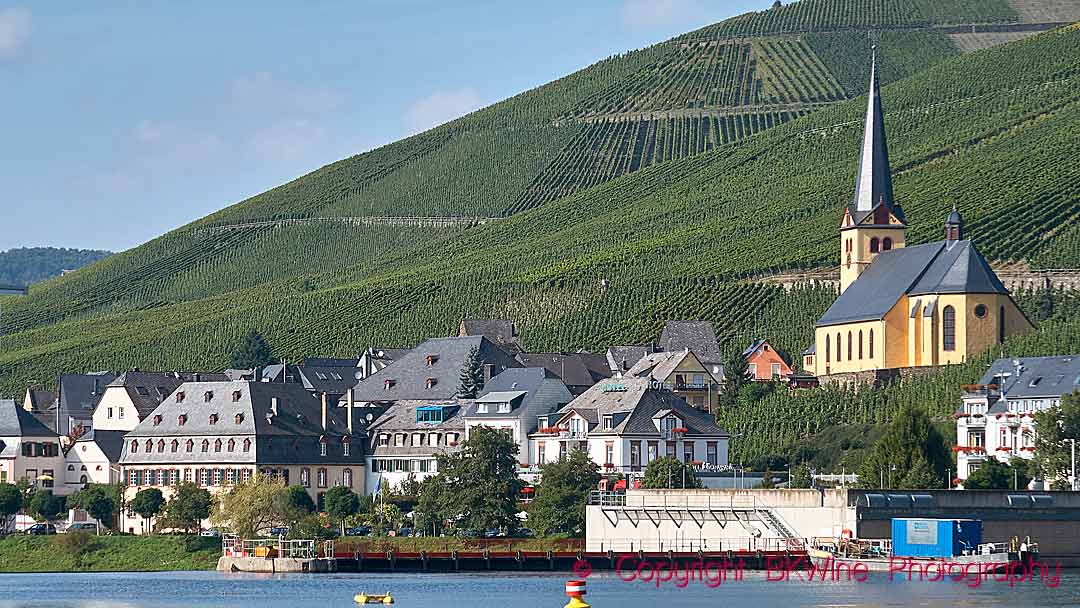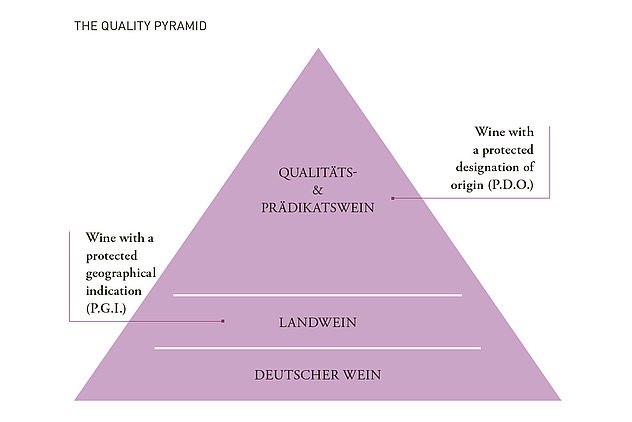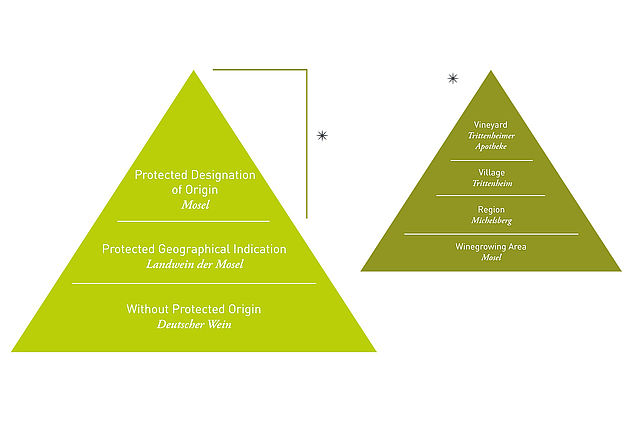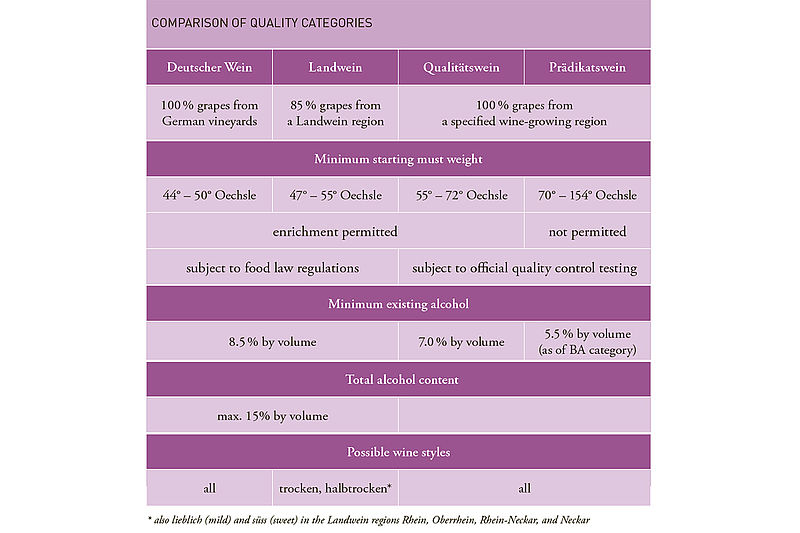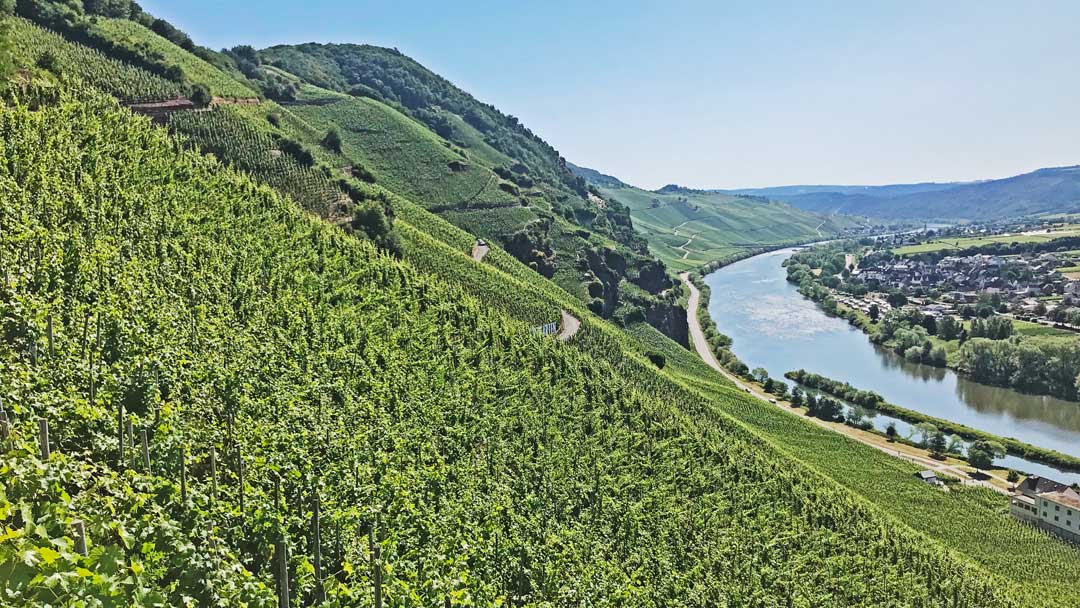Germany introduces a wine hierarchy based on geography
Germany has introduced a new “classification” system for its wines, under the name Qualitätswein. It creates a hierarchy of wines – Area, Region, Village and Vineyard – with increasingly smaller units. It is assumed that “smaller is better”. The existing system with Prädikat will remain in place. The two will work in parallel. We explain the details of the new German geographic quality wine system and how it will work together with the existing system.
On January 27, 2021 the new German wine law came into force. It introduces a new kind of hierarchy for German wines based on its geographic origin. In a way it can be seen as a remodelling of the system that previously existed with the aim to improve the overall quality of German wine as well as to fit better with the EU system. The four primary geographic “levels” for a German quality wine (Qualitätswein) are now Area, Region, Village, and Vineyard.
The implementation will be progressive and will be binding from the 2026 vintage.
This is a longer version of an article published on Forbes.com.
At the same time, the existing hierarchy with Prädikat, based on must sugar levels will remain in place. So, there will, in essence, be two parallel and complementary systems in place, the new Qualitätswein based on a geographic hierarchy, and the current system with Prädikat, based on must concentration.
Let’s start by putting the German system in the context of the EU wine legislation (as defined in the wine reform in 2009). You can find an overview of the EU wine classification system here.
This is how the new German hierarchy looks, placed in the EU-grid, from the bottom (simplest) to the top:
- Wine without a geographic designation
- “Deutscher Wein” (German wine)
- Wine with a geographic designation
- Protected Geographical Indication (PGI), German: g.g.A. or geschützten geografischer Angabe
- Landwein
- Protected Designation of Origin (PDO), German: g.U., geschützter Ursprungsbezeichnung, usually called Qualitätswein
- Area: Entire wine growing area. Anbaugebiet
- Region: Specified areas, previously Bereich or Grosslage
- Village: Ortswein
- Vineyard: Einzellage
- Erstes Gewächs
- Grosses Gewächs
- Gewannen: Possibility to specify parcel names for Erstes and Grosses
- Vineyard: Einzellage
- Village: Ortswein
- Region: Specified areas, previously Bereich or Grosslage
- Area: Entire wine growing area. Anbaugebiet
- Protected Geographical Indication (PGI), German: g.g.A. or geschützten geografischer Angabe
Keep in mind that the German category Qualitätswein previously has had two groups:
- Qualitätswein, or previously QbA – Qualitätswein bestimmter Anbaugebiete, from one of the 13 wine regions (Anbaugebiete)
- QmP – Qualitätswein mit Prädikat
QmP was (and is) in turn subdivided mainly according to the sugar contents of the must, the must weight (Öchsle), into the Prädikat:
- Kabinett
- Spätlese
- Auslese
- Beerenauslese
- Eiswein
- Trockenbeerenauslese
The new German geographic hierarchy
The below description of the new regulation is mainly based on the information from the German Wine Institute regarding Qualitätswein.
In the new geographic pyramid it is presumed that the smaller the geographic area is, the better the wine is. From the top of the new geographic pyramid to the bottom of the pyramid of the protected designation of origin, or what in German they call Qualitätswein, these are now the general requirements:
1 A. Grosses Gewächs
This is the top level in the new German hierarchy. You can think of it as grand cru or great growth in German.
- Single vineyard wines, or smaller parcel
- Red or white wine
- Single grape variety
- Match regional taste profile
- Hand-picked
- Maximum yield 50 hl/ha
- Minimum 12% potential alcohol
- Dry (trocken)
- Tasting by a committee
- Vintage must be indicated
- White wines on sale from September 1 the year following the harvest, reds from June 1, second year after harvest (9 months later than the whites)
1 B. Erstes Gewächs
The second level from the top, below Grosses Gewächs. You can think of it as premier cru or first growth in German.
- Single vineyard wines, or smaller parcel
- Red or white wine
- Single grape variety
- Match regional taste profile
- Must be picked “selectively”
- Maximum yield 60 hl/ha on flat land, max 70 hl/ha on steep slopes
- Minimum 11% potential alcohol
- Dry (trocken)
- Tasting by a committee, can be required by the region protection association
- Vintage must be indicated
- Wines on sale from March 1 following the harvest
This is the same kind of points as for Grosses Gewächs, but with somewhat lower requirements. You can compare point by point.
As mentioned above, it is possible to indicate a smaller parcel within a vineyard, a Gewann (Gewannen in plural), for Erstes and Grosses Gewächs, provided it is entered in the vineyard register.
For the Grosses Gewächs and Erstes Gewächs wines, the region protection associations determine the grape varieties and other special sensory characteristics that match the regional profile. They can also define additional requirements for the use of the designations, such as certain maximum yields per hectare or minimum must weights.
1 C. Einzellage, vineyard
For all other still wines and sparkling wines with a designation of an individual vineyard or “classified site”, they may be produced from one or more grape varieties, as specified by the associations. The grapes must be ripened to at least Kabinett quality (according to the Prädikat system). The earliest time for these wines to be sold is also March 1st of the following year.
The name of a single vineyard must always be given on the label together with the name of the village or district.
It is perhaps worth pointing out that Grosses and Erstes Gewächs, the top levels of Einzellage wines, must be dry, but other Einzellage wines can be sweet.
2. Village, Ortsweine
This is village wines.
- Still or sparkling wines (sekt)
- Bears the name of a village or a “district”, geimende (more like a “commune”), as a designation of origin
- Reflects the characteristics of the local vineyards
- The must should be of at least Kabinett quality
- Sold from December 15 the year of the harvest
3. Region wines
Below the level of village wines we have region wines:
- Still or sparkling wine
- Grapes come from a Bereich (wine-growing area) or from a Grosslage (collective site with comprising several vineyards)
- “Region” should be indicated in front of the name of the Bereich or the Grosslage on the label
- (A district, Gemeinde, or part of a village name may no longer be used together with a Grosslage)
4. Area, Anbaugebiete
At the lowest level of the Qualitätswein pyramid: “wines from a specified winegrowing area”, one of the 13 German “Anbaugebiete”, Mosel, Baden, Rheingau, Pfalz etc. (Here it risks getting slightly confusing, since I almost wrote “one the 13 German wine regions”, as one is wont to do. But “region” is the name chosen for the next level up in the pyramid, so one has to be careful. Perhaps we need to get used to calling it “the 13 German wine areas” instead.)
- Still or sparkling wines
- Requirements remain the same as previously for Qualitätswein from an “area” (Anbaugebiet)
“Qualitätswein” can be replaced by the indication “wine with a protected designation of origin” (g.U., geschützter Ursprungsbezeichnung) combined with the name of a winegrowing area.
The “simple” summary of Qualitätswein
So, if I try and summarise all of this, lets express it in a few “pyramids”.
The EU has a tree-level pyramid of wine
- Wine with a geographic origin – Protected Designation of Origin
- Wine with a geographic origin – Protected Geographical Indication
- Wine without a geographic origin
In Germany this translates into a three-level pyramid, similar to many other countries:
- Qualitätswein
- Landwein
- Deutscher Wein – without geographic origin
The top level of this pyramid, Qualitätswein, splits into four levels:
Qualitätswein:
- Vineyard (Einzellage)
- Village (Ortsweine)
- Region
- Area wine (Anbaugebiete)
The top level of the Qualitätswein pyramid, the single-vineyard level, has four different categories:
Vineyard wine:
- Gewann, sub-plot, may be specified
- Grosses Gewächs (grand cru)
- Erstes Gewächs (premier cru)
- Einzellage, vineyard
The Qualitätswein, including Prädikat, represent more than 90% of all German wine. Note: A vineyard (Einzellage) can be either an Erste Gewächs (first growt) or a Grosse Gewächs (great growth). Either of those two may have a sub-plot (Gewann).
Prädikat
However, for Qualitätswein the old system with Prädikat for increasingly sweet wine still exists, so a parallel quality pyramid is the old one based mainly on must weight (must sugar contents). The requirements vary from area (Anbaugebiet) to area:
- Qualitätswein mit Prädikat (increasing must weight)
- Kabinett
- Spätlese
- Auslese
- Beerenauslese
- Eiswein
- Trockenbeerenauslese
This means, as far as I understand, that a Qualitätswein can be labelled with both the new geographic terms and with the Prädikat. In fact, quite similar to how it worked previously. So, for example, you can have a “village” wine with an “Auslese” Prädikat.
So what about all the rest, which is not Qualitätswein or Prädikatswein?
Landwein
The category below the Qualitätswein, quality wines, is called Landwein or g.g.A. which stands for geschützten geografischer Angabe. This comprises 26 regional designations. Landwein should be “typical” of the region. At least 85% of the grapes must come from the region (in some cases 100%). Names of villages or vineyards must not be mentioned on the label.
Landwein accounts for less than 10% of all German wine.
You can find a list of all 26 Landwein regions here.
Deutscher Wein
Deutscher Wein is the lowest quality level of German wine. The only specified origin is “Germany”. However, the vintage and the grape variety can be mentioned.
Very little Deutscher Wein is made.
Read more on German wine on GermanWines.de.
German wine classification overview
Here’s an overview of the different categories with some of the basic requirements:
How will this work in practice?
It was not quite clear to me how this would work in practice. What wording will you find of labels? What must be indicated on the label? What can be indicated on the label? Will you have know what the various geographic terms are, so, for example know if a name is a vineyard or a village? I took my questions to Ernst Büscher, press contact at Wines of Germany, who kindly answered my questions. Here’s (slightly amended) his explanation:
Only the name of the area (Anbaugebiet, like, for example, Mosel, Pfalz) has to be labelled on every Qualitätswein and Prädikatswein and together with all the other categories (Region, Ort, Einzellage). But the term “Anbaugebiet” itself does not have to appear on the label. The Anbaugebiet is a kind of “major category” like “Landwein” or “Deutscher Wein” (the two categories below Qualitätswein) which always have to be on the label. In principle this is no change from the current (old) system.
In the new category “Region wines”, the term “Region” replaces the name of the village of a Großlage. That means that instead of e.g. “Piesporter Michelsberg” it will say on the label “Region Michelsberg” or, for example, in Baden it will say “Region Kaiserstuhl” instead of “Bereich Kaiserstuhl”.
A district, or commune (Gemeinde, like e.g. Piesport), or part of a village name (like e.g. the name Gimmeldingen) may no longer be used together with the name of a Großlage. This will be only permitted for single-vineyard wines.
The term “Einzellage” will not be put on the label. Here it is assumed, that the consumer knows that e.g. “Deidesheimer Paradisgarten” is a vineyard site.
The new categories “Großes Gewächs” and “Erstes Gewächs” have to be labelled together with the terms and the vineyard site. This makes sense because the wine makers will want to show these premium categories.
Every Prädikatswein may be labelled as Qualitätswein, but not vice versa. If a grape must has reached a minimum sugar level like e.g. 90 degree Oechsle, the wine can be labelled with the Prädikat “Spätlese” but the wine maker can also sell it as a Qualitätswein. Due to the climate change, many wine makers do that quite often. This practice did not change in comparison to the existing wine law.
The existing Prädikat system (Kabinett, Spätlese, Auslese, Beerenauslese, Eiswein, Trockenbeerenauslese) is independent from the pyramids of origin. It will theoretically be possible to have e.g. a Spätlese in all Qualitätswein levels (Anbaugebiet, Region, Ort, Einzellage).
Germany vs. France, comparison – and conclusions
The new Germany hierarchy based on geography (Area, Region, Village, Vineyard) is in some ways similar to what exists in France. But it is also very different. In France, a smaller the geographic area is “generally considered” better than a bigger geographic area. For example, Pauillac is considered better than Médoc. But there is no formal hierarchy, similar to that which has been defined in Germany. It just so happens that some small appellations are part of bigger ones. There’s no formal hierarchy with different classes. Some regions have several “levels”, like Bordeaux, whereas other regions have only one single and unique level, like Champagne. The exception is Burgundy, where there is a more formal hierarchy, similar to the one in Germany, with region, village, vineyards, premier cru and grand cru.
However, the German system is not entirely new. It is based on the existing structure with Anbaugebiete, Grosslage etc, but formalises and structures it in a nation-wide way.
Will it make life easier for the wine consumer?
At first glance, it looks exceedingly complex. How am I to know if (say) Himmeltarfpollen is a Grosses Gewächs (a prestigious grand cru) or a simple village?
But maybe it will not be so complex after all. We are used to similar things in other countries (Barolo is “better” than just Piedmont, Pauillac is “better” than just Bordeaux). But in other countries it is rarely so strictly codified.
We only have 13 Anbaugebiet so those should be easy to remember, and important to know to understand the style of the wine.
Next level up, “Region” must be mentioned on the label if it is a regional wine.
Where it gets difficult is when it comes to village (Ortswein) and vineyard (Einzellage). You need to know if a certain name is a village or a vineyard. Well, we will just have to study our maps.
And for the top two levels, Erste Gewächs (premier cru) and Grosse Gewächs (grand cru), it will surely be proudly and clearly indicated on the label.
We will have to wait and see how it works in practice. It will be a good excuse to discover some new and delicious German wines.


